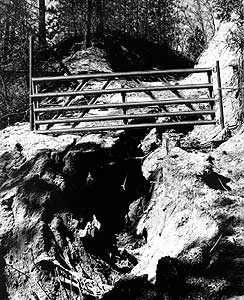Grading Ordinance—Do We Need One?
Grading is primarily undertaken for the construction of roads, building pads, new sewage disposal systems and many other earthmoving needs. “Grading” includes earthmoving activities such as excavating, placement of fill, terracing hillsides, clearing away natural vegetation to begin construction, or contouring. A grading ordinance provides one means to control erosion, prevent damage to off-site property, avoid creation of unstable slopes or filled areas and protect streams from accelerated rates of sedimentation. A grading ordinance is typically adopted by a county in order to promote and protect public safety, convenience, comfort, prosperity, general welfare, and natural resources.
Is a grading ordinance needed in Trinity County?
Over the past five years there has been a lot of attention given to grading problems in Trinity County. Grading within sensitive areas such as floodplains, streams zones and steep hillsides for driveways, roads, building pads and other projects has increased, because much of the flat, private land in the County already has been developed. Many landowners have not been able to obtain building permits due to poor grading practices including inadequate compaction of fill material, damage to leach field areas or the creation of unstable slopes. In some cases, damage has occurred in buildings, parking lots and roads, due to these unstable soils settling underneath of the structures.
 |
The case for better grading practices and erosion control techniques has been building for a long time. In 2000, the federal Environmental Protection Agency (EPA), while studying a portion of the Eel River, found that the percent of sediment from small landowner and county roads was actually increasing proportional to timber industry related sediment. The study found that erosion from timber management has been decreasing over the past 15 years, because improved grading practices, road designs and drainage controls have been implemented. Many of these improvements were the result of changes in the Forest Practice Act regulations. Similar changes had not been implemented on county roads or on those of small, private land holdings within the Eel River basin.
In 1997, a lawsuit filed under Section 303(d) of the Federal Clean Water Act (Pacific Coast Federation of Fishermen’s Associations v. Marcus) resulted in the designation of all rivers of Trinity County as sediment impaired due to past and/or current human activities including mining, logging, and the construction of roads and dams. Once this designation was made, the EPA and the North Coast Regional Water Quality Control Board were held responsible for establishing sediment load allocations for these river systems and for adopting an implementation plan to achieve these allocations, called Total Maximum Daily Loads. (visit www.epa.gov/region09/water/tmdl for more on sediment load limits and Section 303(d) of the Clean Water Act). The US EPA adopted these limits for the South Fork Trinity River in 1998 and for the Trinity River and all of its tributaries in 2001.
There are other indicators that grading practices are a concern. The National Oceanic and Atmospheric Administration, Fisheries Branch (formerly National Marine Fisheries Service) has said that high sediment levels can clog salmon spawning gravels reducing fish reproduction. This and many other factors led to the federal listing of the Coho salmon as a threatened species in 1997. In August 2002, the California Fish and Game Commission followed the federal lead and listed the Coho as a state threatened species. State and federal agencies also have looked at steelhead populations and have reviewed their status under endangered species regulations, with no listings to date. In addition, the California Department of Fish and Game and North Coast Regional Water Quality Control Board have issued fines and increased enforcement of water quality rules in response to citizen complaints, increasing the urgency for local governments to provide guidance to landowners, those maintaining our
road network and equipment operators.
Improved grading practices could be one tool in our management toolbox to help us be the best stewards of our land and water resources, and maybe a locally-led approach will be better for Trinity County than having the State of Federal Government tell us how we should respond to these issues.
|


